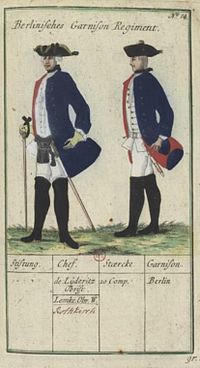Old Prussian Berlin Land Regiment BL
|
Berlin Land Regiment |
|
|---|---|
 Officer and musketeer of the Berlin Land Regiment, 1770 |
|
| active | 1729 to 1788 (dissolved) |
| Country | Prussia |
| Branch of service | infantry |
| Former locations | Berlin |
| owner | 1729–1740: Anton von Blankensee ; 1740–1747: Karl Friedrich von Kraatz ; 1747–1763: Friedrich Wilhelm von Lüderitz ; 1763–1767: Christian Ernst Emanuel von Lembcke ; 1767 (January 14th to April 27th): Ernst Friedrich von der Heyden ; 1767–1782: Johann Sylvius von Rothkirch ; 1782–1788: Karl Friedrich Albrecht von Loeben |
| Tribe list | Old Prussian infantry regiments |
| Trunk number | 1 |
| Wars & major battles | Seven Years War - Berlin Hussar coup (1757), Second occupation of Berlin (1760) |
The Berlin Land Regiment was an infantry regiment of the Old Prussian Army .
history
The Berlin Land Regiment was set up in 1729 by King Friedrich Wilhelm I and was originally called the New Garrison Regiment No. 1 or Berlin Garrison Regiment . The teams were former soldiers - exclusively Prussian regional children - of the Kurmärk and Neumärk field regiments, who had been granted farewell on the condition that they undertook to serve in the Berlin garrison regiment, which played the role of a militia .
From 1756 onwards the name Berliner Land-Regiment became established in unofficial usage , but it was not until after 1773 that it was also listed under this name in the regular lists and rankings of the Prussian army. In the accounts of the General War Chest, the original name from 1729 remained in use until the unit was dissolved.
In 1788 the Berlin Land Regiment was dissolved.
Organization and strength
Without exception, the team ranks were regarded as unpaid and permanently on leave. Most of the year they stayed in their hometowns; only once a year they were brought together for 14 days for exercise in Berlin . During this time they received pay, and also when they were used on other occasions. The officers , NCOs and Tambours were on duty all year round, but were permanently on half pay.
Even more than with the garrison regiments, which are considered to be of secondary importance, a transfer to the land regiment was extremely unpleasant: It was considered a collecting tank for officers who were no longer fit for duty or as a punishment and deportation unit for officers who had received negative attention. Since the crews were unpaid except for short periods of time, the company commanders did not have the usual and permissible option within the company economy to withhold the pay of those on leave and free guards themselves. This was particularly painful as the officer's wages, which were already very meager, had been halved in the Land Regiment.
When it was set up in 1729, the Berlin Land Regiment consisted of 7 companies of 200 men each. Under Frederick II there was an increase to 10 companies in 2 battalions . Unlike the standing garrison regiments, the land regiment did not have grenadier companies ; the unit consisted entirely of musketeers .
use
In contrast to the standing garrison regiments, which were repeatedly used as field regiments during the Seven Years' War , the Berlin Land Regiment was not intended for combat use. That was forbidden because the unit mostly consisted of older or partially disabled soldiers. The real task of the regiment was to take up the post at the military guards and the city gates of Berlin when the field regiments otherwise garrisoned in the city were deployed to revue or to perform autumn maneuvers . In addition, the land regiment was only to appear defensive locally in exceptional cases in times of war, which was also necessary during the Seven Years' War.
Fighting
- October 16, 1757: The Land Regiment takes part in the fighting of the Berlin hussar coup .
- October 3 - 9, 1760: A battalion of the Land Regiment fights in Berlin against Russian and Austrian troops, which eventually occupy the Prussian capital for a few days
- October 4, 1760: A 60 man strong unit of the land regiment fights in Koepenick against the Russians and Austrians advancing on Berlin.
Uniformity
When it was set up, the regiment wore simple gray skirts with red cuffs and red lining, plus Prussian blue vests and trousers as well as black tricorns and gaiters .
Under Friedrich II the skirts were Prussian blue as with the rest of the infantry, the cuffs were kept in the same color and the lining was red; The waistcoat and trousers were white. Tricot and gaiters remained unchanged in black.
Since the ordinary soldiers were not paid, the cost of the uniform was not deducted from their wages, as is usually the case, but they received the clothing in full.
Heads of regiments
- 1729–1740: Anton von Blankensee
- 1740–1747: Karl Friedrich von Kraatz
- 1747–1762: Karl Friedrich von Lüderitz
- 1763–1766: Christian Ernst Emanuel von Lembcke
- 1767 (January 14th to April 27th): Ernst Friedrich von der Heyden
- 1767–1782: Johann Sylvius von Rothkirch
- 1782–1788: Karl Friedrich Albrecht von Loeben
literature
- Johann von Heilmann: The Art of War of the Prussians under King Frederick the Great , Volume 1. Goedsche, 1852, digitized
- René de L'Homme de Courbière: History of the Brandenburg-Prussian Army Constitution . Publishing house of Decker's Secret Upper Hofbuchdruckerei, 1852, digitized
- R. Braeuner: History of the Prussian Landwehr: Historical representation and illumination of their prehistory, establishment and later organization , Volume 1. Mittler, 1863, digitized
- Günther Gieraths : The fighting of the Brandenburg-Prussian army . Walter de Gruyter, 1964